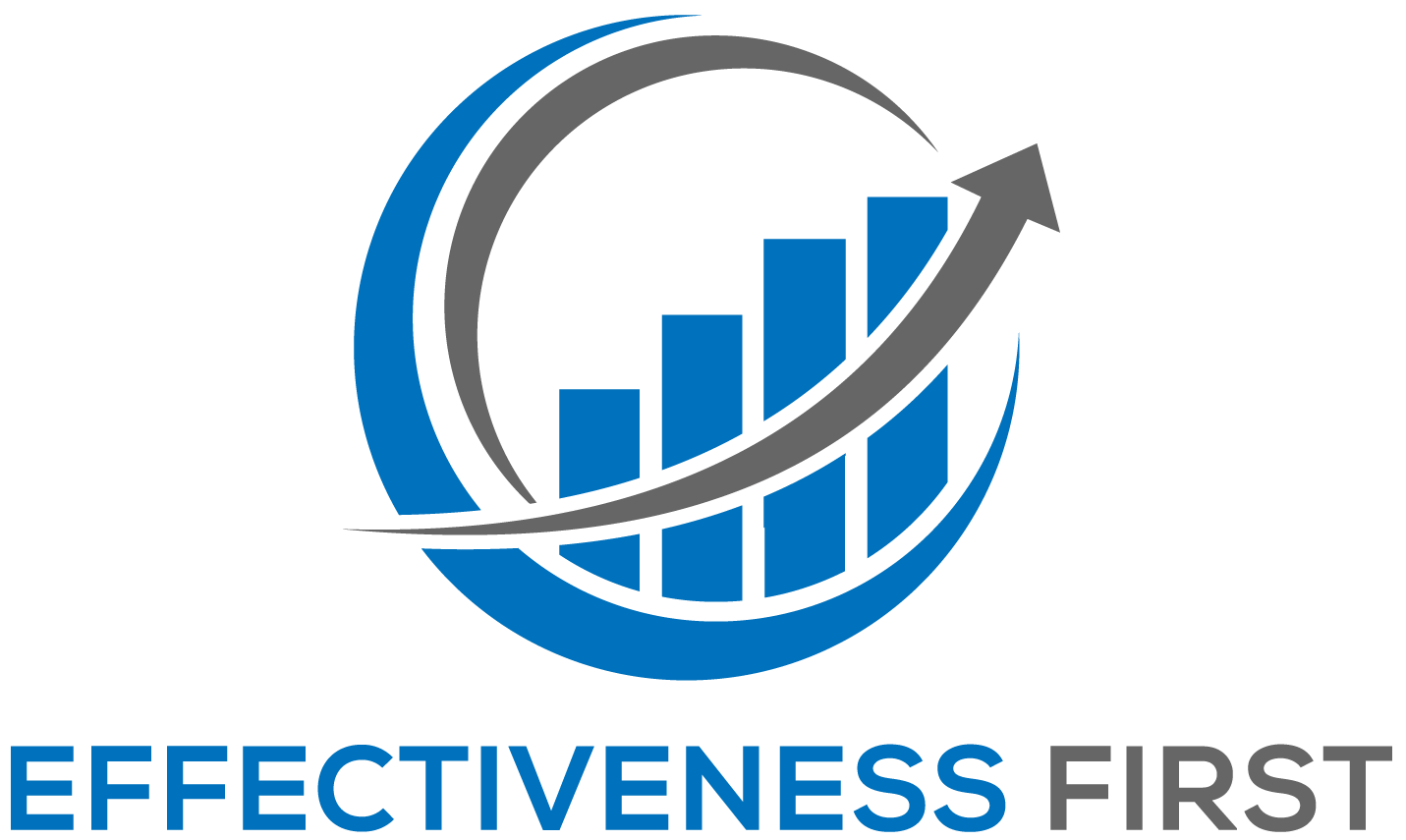Efficiency is the job of managers; Effectiveness is the responsibility of leaders.

Napoleon Bonaparte famously said, “Amateurs talk about tactics, professionals talk about logistics.” The same applies to leadership—those who prioritize efficiency fall short compared to those who focus on effectiveness.
Now, brace yourself—this article may sting a little. We’ve all chugged the efficiency Kool-Aid at some point, and unfortunately, some leaders are still hooked. When we were managers, efficiency was our job. But when we stepped into leadership, our role shifted to ensuring overall effectiveness. That meant handing over the minutiae of management.
Why? Three big reasons:
- If we’re buried in internal efficiency tweaks, who’s actually leading the organization forward?
- When “leaders” try to manage efficiency the actual managers either disengage in frustration or double down on micromanaging to impress us, creating a joyless, innovation-stifling environment.
- If leaders don’t focus on effectiveness no one will. and now one will learn how to.
The Dashboard Delusion
The biggest blunder of “efficient leaders” is obsessing over the wrong dashboards. In 22 years of teaching data analysis, I’ve seen few dashboards that didn’t do more harm than good. Worse, the so-called “leader” (read: head manager) often has no clue.
Good leaders succeed despite their dashboards, relying on experience and intuition. Inexperienced leaders and bureaucrats, however, cling to pretty charts, mistaking them for actual insight. Their dashboard is their happy place, while employees nod along, secretly thinking, “Of course they don’t understand what’s really happening.” Sound familiar?
 This isn’t new. Hans Christian Andersen warned us with The Emperor’s New Clothes. In that tale, the emperor is duped into parading around naked while everyone is too afraid to tell him the truth. Today, dashboards and analytics are the modern version of that empty wardrobe. Truly, “There is nothing new under the sun” (Ecclesiastes 1:9).
This isn’t new. Hans Christian Andersen warned us with The Emperor’s New Clothes. In that tale, the emperor is duped into parading around naked while everyone is too afraid to tell him the truth. Today, dashboards and analytics are the modern version of that empty wardrobe. Truly, “There is nothing new under the sun” (Ecclesiastes 1:9).

The Efficiency Trap
Efficiency worship isn’t new either—it dates back to the Industrial Revolution and Winslow Taylor’s Scientific Management in the early 1900s. Today, it lives on in Lean management programs and has been turbocharged by easy-to-use analytics tools. These tools are powerful, no doubt—but power cuts both ways.
Most dashboards measure inputs and outputs, not outcomes. That’s a problem. They lock organizations into a cycle of maximizing efficiency—saving time, cutting costs, increasing output—without considering whether they’re actually achieving anything valuable. If your leadership team is obsessed with efficiency-based dashboards, I guarantee they’re harming your organization.
Peter Drucker said it best: What gets measured, gets managed—at the expense of everything else.
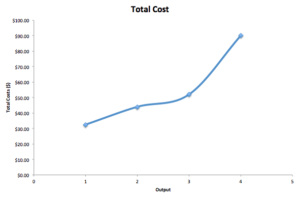
The Problem with Efficiency Metrics
Efficiency is a seductive lie because it simplifies everything into two factors: resources consumed and productivity. That’s why it looks great on a two-axis chart—clean, simple, easy to digest.
But beware of any metric that includes “cost of,” “time to,” or “per.” These only tell part of the story. Your monthly productivity histogram? Just another efficiency metric disguised as insight.
Efficiency always leaves something out. It ignores trade-offs, stakeholders, and external factors. Every time you hear “efficiency,” remember: someone, somewhere, is paying the price. As Milton Friedman said, “There’s no such thing as a free lunch.”
 With efficiency, vary rarely is there a true savings to all stakeholders. The term disruptive technology which is used to signify a monumental step forward actually implies the losers in the term. Those that are being disrupted are losing. I’m not saying this is good or bad because we need winners and losers in business as a way of setting new standards and “culling the herd”, but the impact to other stakeholders is an important consideration.
With efficiency, vary rarely is there a true savings to all stakeholders. The term disruptive technology which is used to signify a monumental step forward actually implies the losers in the term. Those that are being disrupted are losing. I’m not saying this is good or bad because we need winners and losers in business as a way of setting new standards and “culling the herd”, but the impact to other stakeholders is an important consideration.
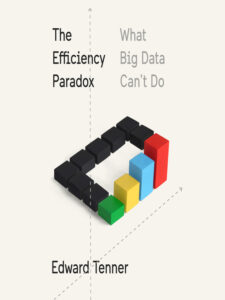 An example of the misleading nature of efficiency as pointed out in the wonderful book The Efficiency Paradox by Edward Tenner. Take Uber. From a customer’s perspective, it’s efficient. But look closer—your two-way trip just became a four-way trip for the driver. Fuel consumption doubles. Traffic congestion increases. The efficiency illusion strikes again.
An example of the misleading nature of efficiency as pointed out in the wonderful book The Efficiency Paradox by Edward Tenner. Take Uber. From a customer’s perspective, it’s efficient. But look closer—your two-way trip just became a four-way trip for the driver. Fuel consumption doubles. Traffic congestion increases. The efficiency illusion strikes again.
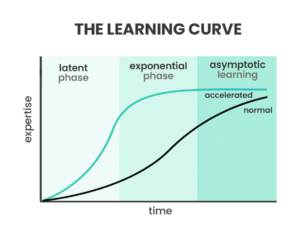 A growing company is by necessity always learning something new. This learning can be plotted on one of the most famous efficiency graphs of all time—the learning curve. It shows how fast people produce a product based on their level of experience. The learning curve demonstrates that all new skills are slow and inefficient in the beginning. However, through practice, people get better which reduces the time per unit. The effectiveness-oriented company understands this and accepts the fact that learning takes resources and time and is inherently inefficient. The efficiency-oriented company is overly concerned about saving time and money so they avoid the inefficiency of learning new things. This results in starving their investment budget and all but kills innovation.
A growing company is by necessity always learning something new. This learning can be plotted on one of the most famous efficiency graphs of all time—the learning curve. It shows how fast people produce a product based on their level of experience. The learning curve demonstrates that all new skills are slow and inefficient in the beginning. However, through practice, people get better which reduces the time per unit. The effectiveness-oriented company understands this and accepts the fact that learning takes resources and time and is inherently inefficient. The efficiency-oriented company is overly concerned about saving time and money so they avoid the inefficiency of learning new things. This results in starving their investment budget and all but kills innovation.
Don’t get me wrong, measuring efficiency is good and appropriate…for managers. In fact, it’s in the name. They manage the process for converting people and resources into products or services. Thus, their job is to control inputs and outputs. All of which is controllable because it’s internal to the organization. Outcomes, however, are a different story. Outcomes are what happens when outputs come into contact with the external environment. Managers are not responsible for the external environment because it can’t be managed. That’s the leader’s job–to pick the environment, shape it the best they can, and establish the standards and focus of the organization. All to give it the best chance of success when it comes into contact with external forces. 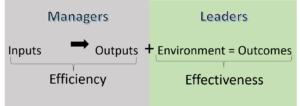 It’s a hard job with a lot of responsibility, including many factors that can’t be controlled. Perhaps it’s even impossible, but that’s why leaders get paid the big bucks. Efficiency is the measure of how successful a manager is but the measure of a leader is how effective they are at achieving all the company’s desired outcomes. Strategic leaders, therefore, need to focus on the bigger picture in order to measure effectiveness.
It’s a hard job with a lot of responsibility, including many factors that can’t be controlled. Perhaps it’s even impossible, but that’s why leaders get paid the big bucks. Efficiency is the measure of how successful a manager is but the measure of a leader is how effective they are at achieving all the company’s desired outcomes. Strategic leaders, therefore, need to focus on the bigger picture in order to measure effectiveness.
Most organizations have several desired outcomes and many support functions which they are required to perform such as finance, logistics, marketing, and many others. These are all necessary and contribute to overall effectiveness but each takes resources. An effective leader understands they have limited resources so they have to make tradeoffs between all of the functions. Maximizing effectiveness, therefore, requires distributing resources strategically in order to optimize the organization’s outcomes. The question is, how?
It is often quipped that “efficiency is doing things right, but effectiveness is doing the right things”. This is a good summary but does not really explain the comprehensive nature of true effectiveness. Measuring effectiveness is thought to be difficult for multiple reasons. A few common reasons are; too many factors, results are subjective, it’s hard to measure, and time frames to see results are too long. To many, this seems daunting. But there’s good news, it’s possible to measure effectiveness and it’s even easy when done correctly.
So here’s the answer to the million-dollar question how do you measure effectiveness? The trick is to create an organizational recipe for success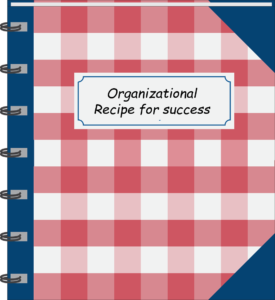 and then measure how successful you are following the recipe. Like a recipe for a delicious meal where the perfect dish depends on timing, process and ingredients, the same is true for any company or organization. Perfecting the recipe will take time, but thankfully there are only three questions:
and then measure how successful you are following the recipe. Like a recipe for a delicious meal where the perfect dish depends on timing, process and ingredients, the same is true for any company or organization. Perfecting the recipe will take time, but thankfully there are only three questions:
- What’s important? are the core business functions you decide to measure.
- How important is it? is determined by weighting each factor in relation to all other factors.
- How much is needed? is answered by establishing a range of acceptable performance for each measured area.
Every leader should already be answering these questions and probably are in their heads, if not on paper.
When the recipe for success is perfected decision-making is easy for leaders and everyone else in the organization because priorities are already spelled out. Making small changes to the recipe is always possible as is analyzing the impact of those small changes.
By measuring effectiveness in this way organizations avoid countless hours churning out unimportant metrics, (ironically, a very inefficient practice). The only added step to measuring effectiveness is calculating the results. The results were always remarkable. In retrospect, it’s obvious why. When leaders make a conscious effort to maximize effectiveness by focusing on what’s most important and then building a recipe for success, 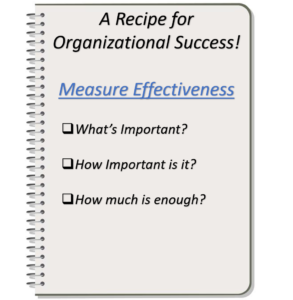 they get exactly what the recipe is designed to produce success! But what was less obvious is how much this process boosted morale and promotes growth. Everyone in the organization understands the priorities, this provides stability, and everyone knows exactly how to control their own fate. Having a recipe for success also ensures consistency throughout the organization which makes maintaining standards easier and dramatically improves continuity during employee turnover. Change becomes as easy as tweaking the recipe. If the new process results in a higher overall effectiveness score, keep the change. If it gets worse, get rid of it. Thus, the organization becomes became a learning and growing organization with one direction, UP!
they get exactly what the recipe is designed to produce success! But what was less obvious is how much this process boosted morale and promotes growth. Everyone in the organization understands the priorities, this provides stability, and everyone knows exactly how to control their own fate. Having a recipe for success also ensures consistency throughout the organization which makes maintaining standards easier and dramatically improves continuity during employee turnover. Change becomes as easy as tweaking the recipe. If the new process results in a higher overall effectiveness score, keep the change. If it gets worse, get rid of it. Thus, the organization becomes became a learning and growing organization with one direction, UP!
